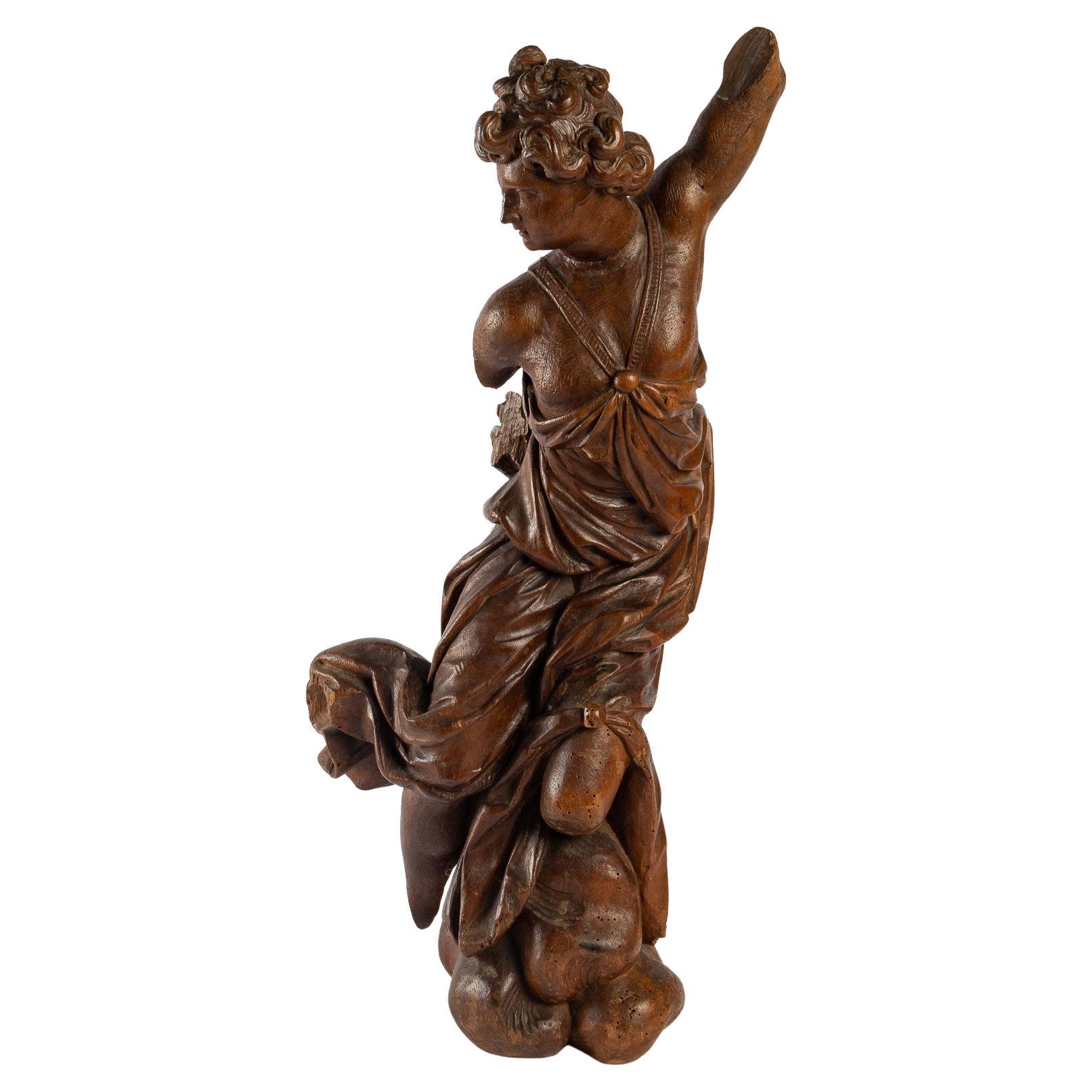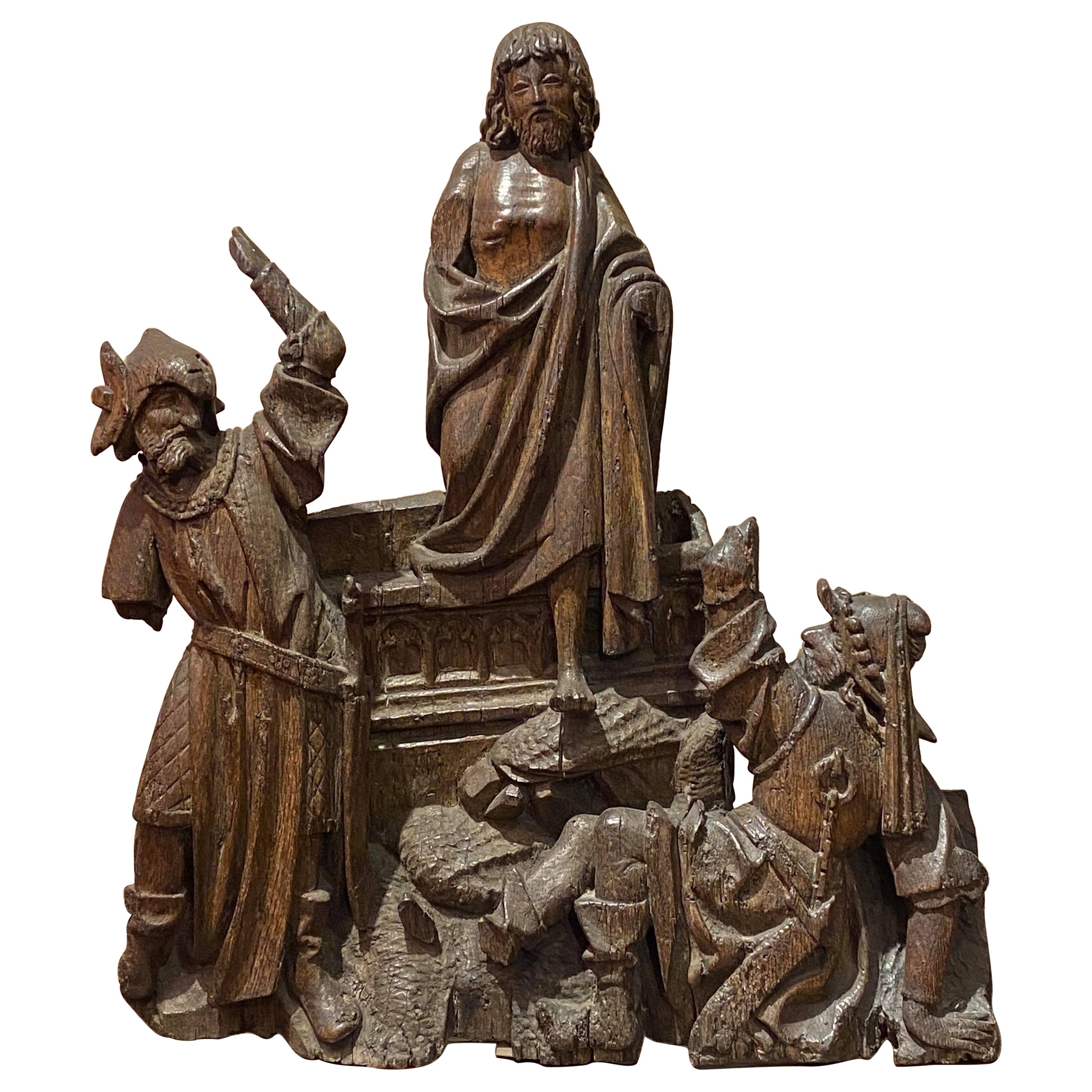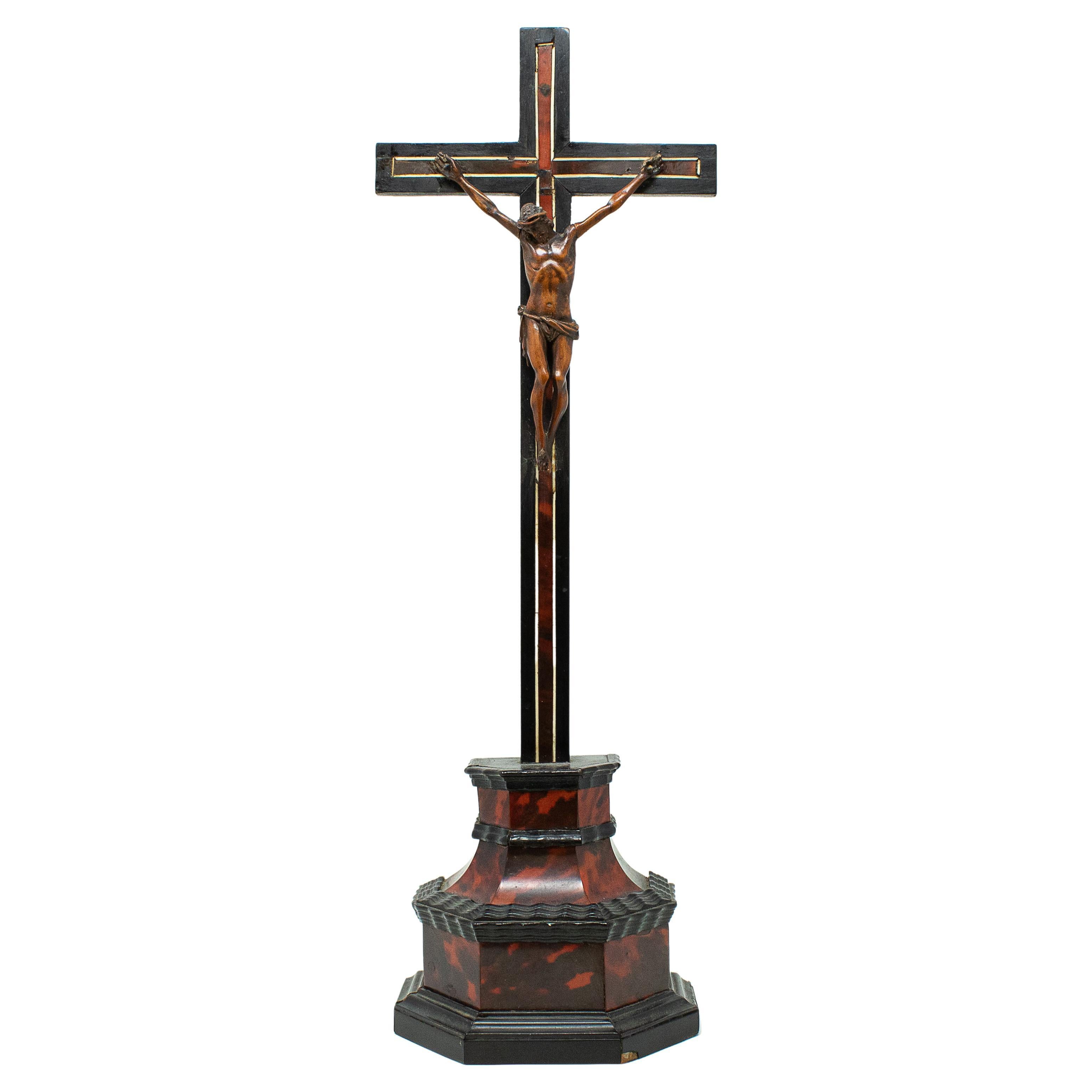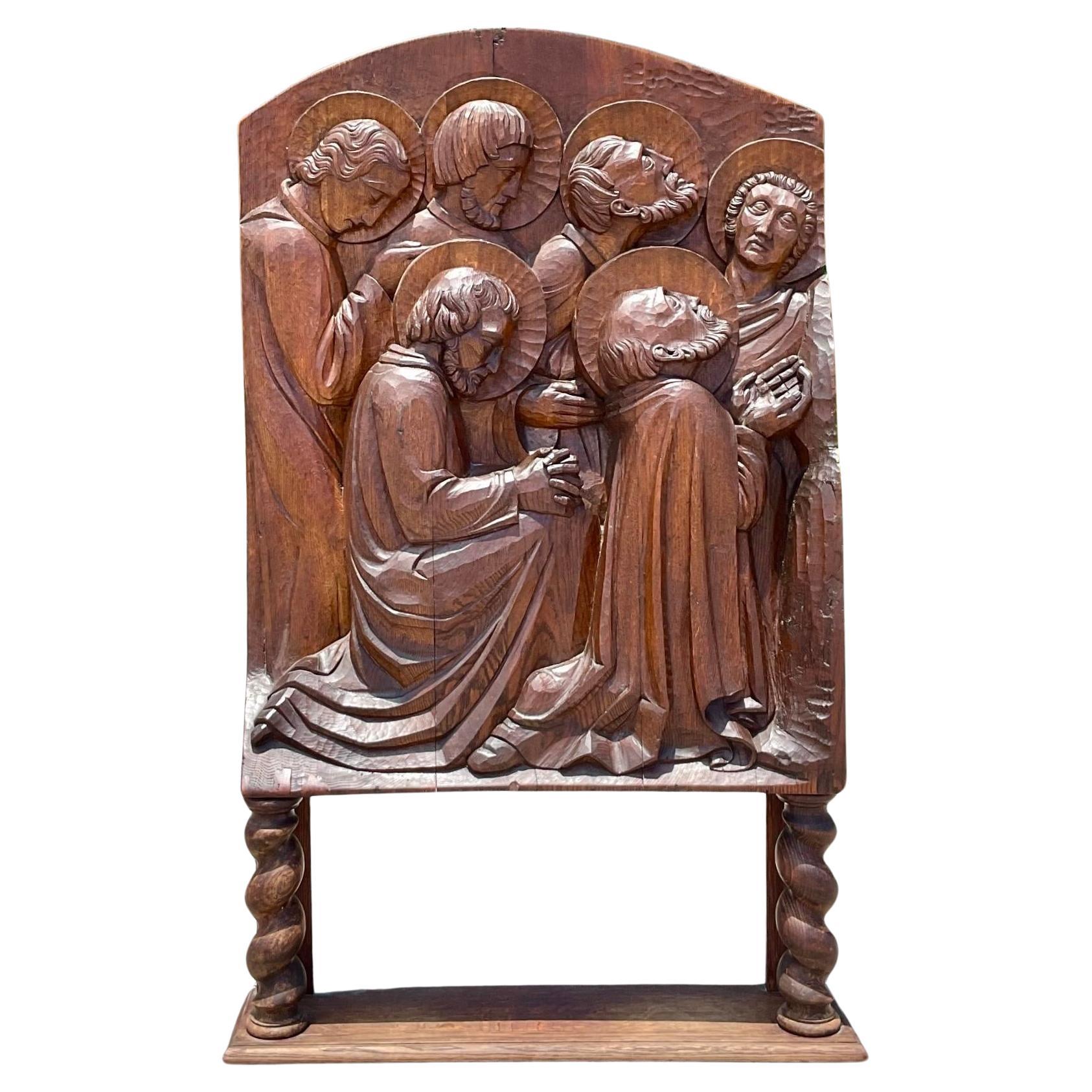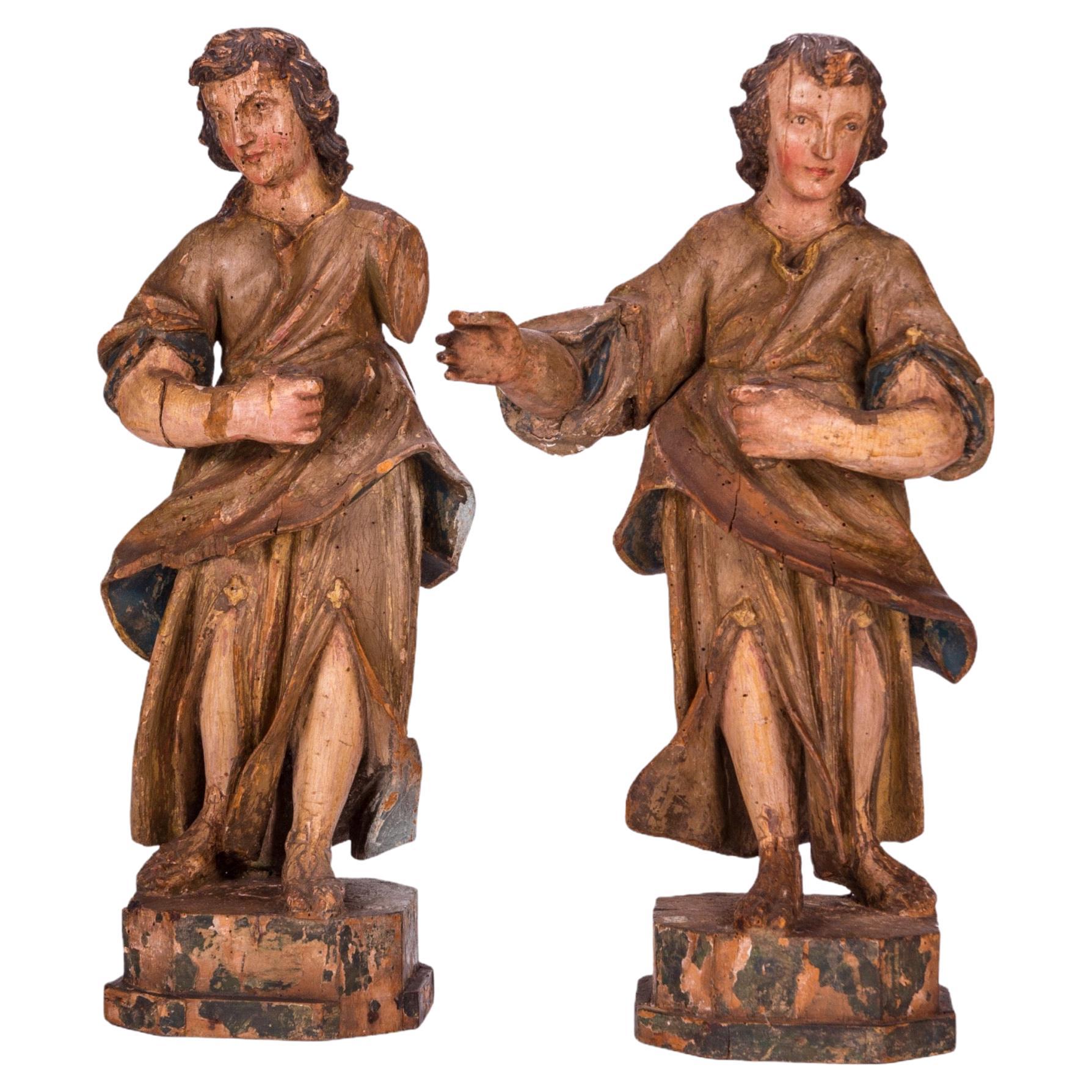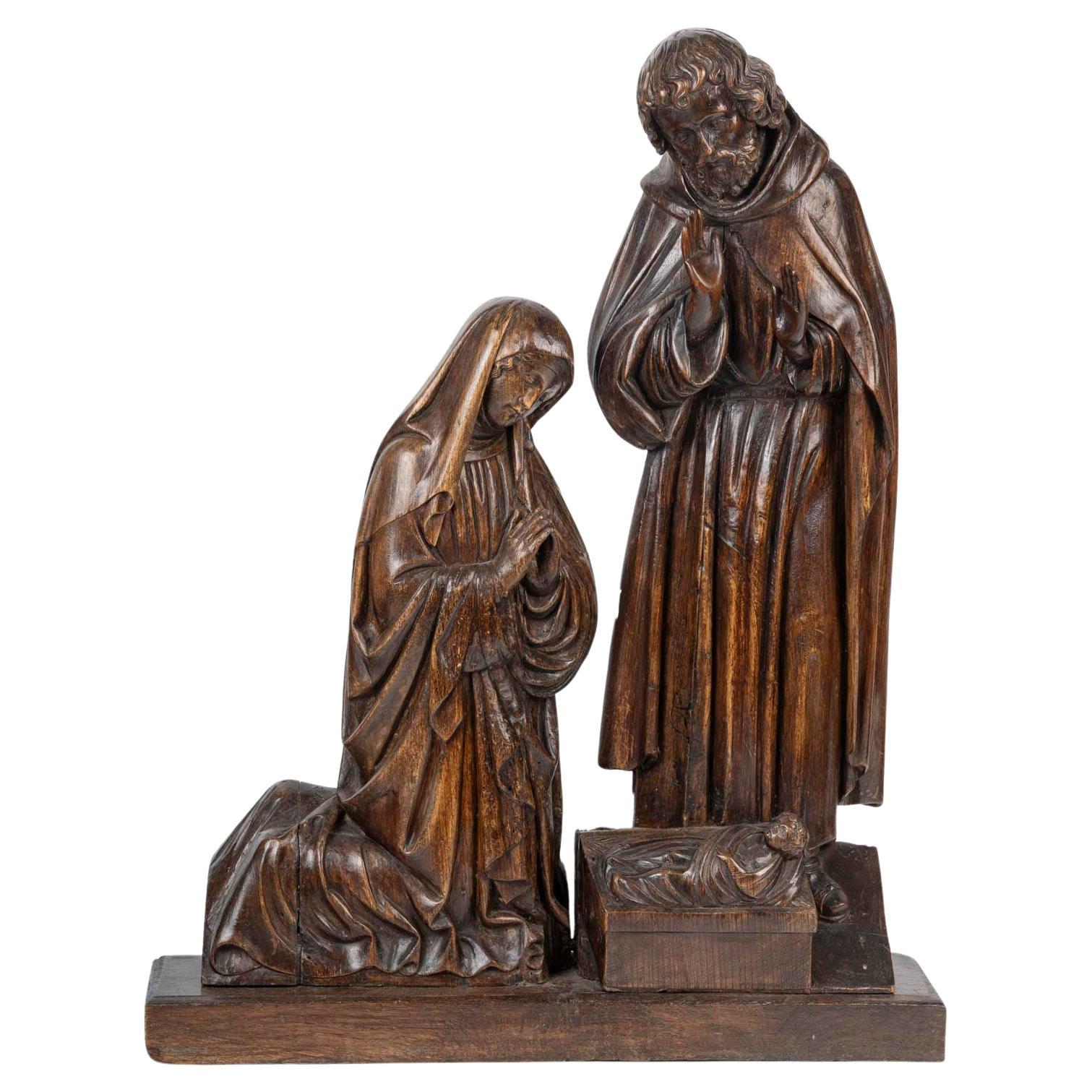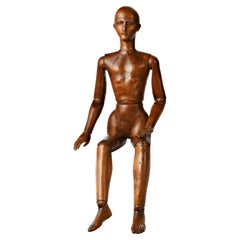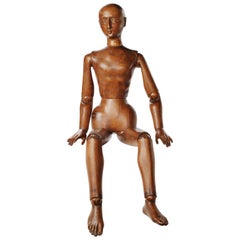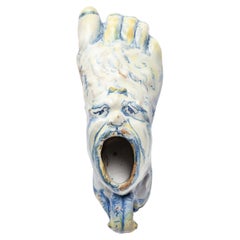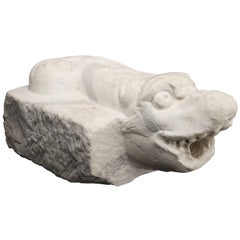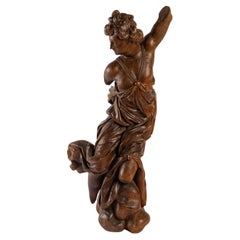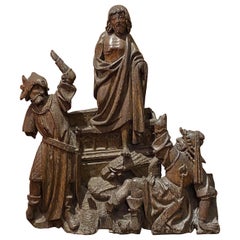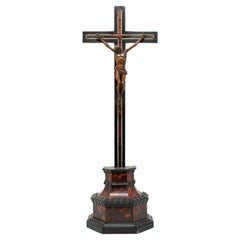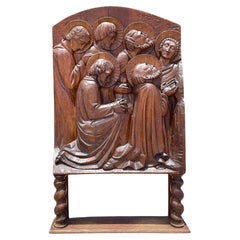Items Similar to Ancient Boxwood Micro Carving Deposition, First Half of the 18th Century
Video Loading
Want more images or videos?
Request additional images or videos from the seller
1 of 22
Ancient Boxwood Micro Carving Deposition, First Half of the 18th Century
$4,783.37
£3,560.30
€4,000
CA$6,656.23
A$7,260.26
CHF 3,814
MX$87,834.30
NOK 47,714.42
SEK 45,051.90
DKK 30,454.39
About the Item
Boxwood micro carving
Deposition
Central Europe, first half of the 18th century
It measures: the sculpture 7.40 x 5.31 x 0.6 in (18.8 x 13.5 x 1.6 cm); with the tablet 9.37 x 8.7 x 1.33 in (23.8 x 20.5 x 3.4 cm)); 0.70 lb (320 g).
State of conservation: slight deficiencies; the micro carving is applied to a wooden tables covered with old green velvet.
The boxwood bas-relief sculpture depicts the moment of the deposition of the body of Jesus from the cross.
Some men are depicted lowering the lifeless body of Christ, while others are shown leaning on the cross and crowding the ladders which rest on the instrument of martyrdom: one supports the body by the shoulders, two hold him up by the arms, two more are preparing to wrap it in a shroud. At the foot of the Cross Mary, women, John, and some apostles in tears attend the scene, ready to receive the body.
The theme of the deposition has been interpreted in various ways throughout the history of art, starting with Medieval depictions, such as that of Antelami in the Cathedral of Parma, and stretching through Donatello, Mantegna, and reaching Caravaggio and beyond. In sculpture, the subject was particularly successful and was reproduced in different materials.
Between about 1524 and 1534, Michelangelo Buonarroti (1475-1564) made a drawing, today at the Teylers museum in Haarlem (see Pope-Hennessy, Catalog of Italian Sculpture in the Victoria and Albert Museum, London 1964, vol. 3, p. 275), in preparation for a Deposition which he did not make, but which had a great influence on many of the subsequent depictions of the same subject.
Inspired by this drawing, Guglielmo Della Porta (1515-1577) made a well-known bas-relief (Galleria Nazionale di Parma. See Jennifer Montagu, Roman Baroque Sculpture: The Industry of Art, Yale University Press 1989, pp. 56-57) which consecrated the fortune of Michelangelo's invention: different versions of bronze, stucco, terracotta and wax are known.
A direct comparison with other works taken from this model however deviates from our work. The bas-relief by Giovanni Della Porta is more consistent with Michelangelo's drawing. The disposition of the characters around the cross does not match: the men who lower the body climb over the cross, the position of Christ's body itself is a bit haphazard, supported by one leg as it is welcomed at the bottom by some characters. The crowd supports Mary and desperately gathers around the cross: the dramatization is greater.
Yet, albeit indirectly, the compositional idea of our small sculpture also derives from Michelangelo's intuition.
Starting in turn from Buonarroti's creation and probably following some subsequent interpretation, Charles Le Brun (1619-1690), between 1679 and 1684, conceived and painted the Deposition for Marshal Villeroy, now preserved at the Musée des Beaux-Arts in Rennes (see C. Nivelon, Vie de Charles Le Brun et description détaillée de ses ouvrages, edited by L. Pericolo, Genève 2004, pp. 479-480; and F. Bergot, Nouvel aménagement: à propos de la Déscente de croix de Le Brun, in Bulletin de la Societé des Amis du Musée des Beaux – Arts de Rennes, 1978, pp. 56-62).
About twenty years later Petit (his first name is not known, nor are his biographical details) obtained from the painting an engraving that was printed in Paris by François Chereu (1680-1729), a famous engraver and publisher (a copy is found in Monza at the Civic Collection of Engravings at the Serrone di Villa Reale, general catalog 00647162).
We do not know if our anonymous carver drew inspiration directly from the painting or, more likely, from the engraving; but the first hypothesis is not to be entirely discarded since the boxwood Deposition has the same orientation as that painted by Le Brun, while the print is a mirror image.
The author of our bas-relief carved the hardwood with a completely personal skill and style of representation and added to the source elements closer to his own experience, modifying somewhat the staging of the scene: the commoners wear hats and robes and other figures are placed at the foot of the cross.
The material used and the artistic style are close to technical products typical of Central and Western Europe, especially in the rendering of the physiognomic features of the figures and in the treatment of the clod of earth on which the scene rests, defined by small parallel carvings.
- Dimensions:Height: 7.41 in (18.8 cm)Width: 5.32 in (13.5 cm)Depth: 0.63 in (1.6 cm)
- Style:Baroque (Of the Period)
- Materials and Techniques:
- Place of Origin:
- Period:1740-1749
- Date of Manufacture:circa 1740
- Condition:Wear consistent with age and use. Slight deficiencies; the micro carving is applied to a wooden tablet covered with old green velvet.
- Seller Location:Milano, IT
- Reference Number:1stDibs: LU4352219432632
About the Seller
4.3
Vetted Professional Seller
Every seller passes strict standards for authenticity and reliability
Established in 1860
1stDibs seller since 2018
21 sales on 1stDibs
Associations
International Confederation of Art and Antique Dealers' Associations
- ShippingRetrieving quote...Shipping from: Milano, Italy
- Return Policy
Authenticity Guarantee
In the unlikely event there’s an issue with an item’s authenticity, contact us within 1 year for a full refund. DetailsMoney-Back Guarantee
If your item is not as described, is damaged in transit, or does not arrive, contact us within 7 days for a full refund. Details24-Hour Cancellation
You have a 24-hour grace period in which to reconsider your purchase, with no questions asked.Vetted Professional Sellers
Our world-class sellers must adhere to strict standards for service and quality, maintaining the integrity of our listings.Price-Match Guarantee
If you find that a seller listed the same item for a lower price elsewhere, we’ll match it.Trusted Global Delivery
Our best-in-class carrier network provides specialized shipping options worldwide, including custom delivery.More From This Seller
View All19th Century Italian Wood Mannequin, Circa 1870-1880
Located in Milano, IT
Mannequin
Sculpted and carved wood
Italy or France, second half of the 19th century.
It measures 25.59 x 6.29 x 3.54 in (65.5 x 16 x 9 cm)
It weighs 2.2 lb circa (1 kg circa)
St...
Category
Antique 1870s Italian Other Figurative Sculptures
Materials
Wood
Late 19th Century Italian Wood Mannequin, circa 1880
Located in Milano, IT
Atelier mannequin
graven and carved stone pine wood
Italy, late 19th century
Measures: H 102 cm x 25 cm x 14 cm
H 40.15 in x 9.84 in x 5.51 in
Weight: circa kg 4
State of conse...
Category
Antique 1880s Italian Other Figurative Sculptures
Materials
Wood
Renaissance Inkwell Calamelli workshop, Italy, Faenza, second half of the 16th
By Virgiliotto Calamelli
Located in Milano, IT
Inkwell
Calamelli workshop (attr.).
Faenza, second half of the 16th century
Height 4.33 in; length 8.07 in; depth 2.95 in (11 cm; 20.5 cm; 7.5 cm)
Weight: 0.800 lb (363 g)
State of conservation: some chipping to the top of the mask around the mouth. Handle glued, without any restorations; minor chips in some raised areas.
This object has the shape of a foot wearing Greek-style footwear, as can be seen in some raised areas. The foot is anatomically modeled with bare toes, while the ankle is partially covered by the footwear. On the heel, there is a small circular handle to support the object. The mouth of the container is shaped like a mask. The interior, completely enameled, suggests that the piece was intended to be used as an inkwell or to contain some other liquid. The base, however, is not enamelled.
The painted decoration, scant and brief, consists of rapid cobalt blue shading between the toes of the foot, with more precise emphasis on the nails. It is accompanied by yellow citrine accents to enhance the forms. The mask is painted with the tip of the brush, to accentuate the tense nature of the eyes and to accentuate their outline. Thin strokes of yellow-orange line the interior of the mouth.
Since the Renaissance, this decoration has been referred to as "compendiaria" and it characterizes the period of production extending from the mid-16th century to approximately the middle of the following century. It significantly influenced tastes at the time. It evolved from the polychrome style "istoriato" and transformed into a new style that "summarized" (compendia), or condensed, the ornamentation of the works into a few colors, placing greater prominence on the shapes. It was often inspired by metal specimens. Since the Renaissance, this decoration has been referred to as "compendiaria" and it characterizes the period of production extending from the mid-16th century to approximately the middle of the following century. It significantly influenced tastes at the time. It evolved from the polychrome style "istoriato" and transformed into a new style that "summarized" (compendia), or condensed, the ornamentation of the works into a few colors, placing greater prominence on the shapes. It was often inspired by metal specimens.
This artwork finds parallels in similar objects all characterized by this refined style and produced in the city of Faenza and other Italian centers starting from the mid-16th century.
The closest comparable example in majolica is a foot acquired by the British Museum in 2011 (inv. 2011, 8008.1). This was previously published by Carmen Ravanelli Guidotti in 1996 and later by Dora Thornton in 2016 during the conference on Renaissance ceramics...
Category
Antique 16th Century Italian Renaissance Inkwells
Materials
Maiolica
Italian Ancient Marble Sculpture Fountain, Late 16th Century
Located in Milano, IT
Sea monster
Carrara marble mouth fountain
Italy, late 16th century
It measures 13.8 x 31.5 x 18.9 in (35 x 80 x 48 cm)
State of conservation: some small evident gaps and widespread signs of wear due to outdoor exposure. The gray marks crossing it do not come from restoration, but are rather the natural veins of the marble.
This work has some morphological characteristics typically associated with the iconography of the sea monster: an elongated muzzle, sharp teeth, protruding eyes, elongated ears, and a coiled serpent's tail.
An in-depth series of studies on artistic depictions of the sea monster attempted to verify how this symbol evolved in antiquity in the European and Mediterranean contexts and how it gradually changed its image and function over time. The iconography itself is mutable and imaginative and its history is rich with cultural and artistic exchange, as well as the overlapping of ideas. This occurred so much that it is difficult to accurately pinpoint the "types" that satisfactorily represent its various developments.
However, we can try to summarize the main figures, starting from the biblical Leviathan and the marine creature that swallowed Jonah (in the Christian version, this figure was to become a whale or a "big fish", the “ketos mega”, translation of the Hebrew “dag gadol”). Other specimens ranged from the dragons mentioned in the Iliad (which were winged and had legs) to "ketos” (also from Greek mythology), the terrifying being from whose Latinized name (“cetus”) derives the word "cetacean". See J. Boardman, “Very Like a Whale” - Classical Sea Monsters, in Monsters and Demons in the Ancient and Medieval Worlds, in Papers presented in Honor of Edith Porada, Mainz am Rhein 1987, pp. 73-84).
In Italy the monster underwent yet further variations: it can be found in Etruscan art on the front of some sarcophagi representing the companion of souls, while among the Romans we find the “Pistrice” (cited by Plinio in Naturalis Historia PLIN., Nat., II 9, 8 and by Virgilio in Eneide: VERG., Aen., III, 427), which appeared in the shape of a stylized hippocampus or a very large monstrous cetacean and evolved into a hideous being with a dragon's head and long webbed fins.
During the Middle Ages, the sea monster was the object of new transformations: at this time, it is often winged, the head is stretched like a crocodile, the front legs are often very sharp fins - sometimes real paws - until the image merges with dragons, the typical figures of medieval visionary spirituality widely found throughout Europe (on this topic and much more, see: Baltrušaitis, J., Il Medioevo fantastico. Antichità ed esotismi nell’arte gotica, Gli Adelphi 1997).
In Italy during the 15th and 16th centuries, the revival of classicism - representative of the humanistic and Renaissance periods - led to a different reading of these "creatures". Indeed, the sea monster was also to find widespread use as an isolated decorative motif, especially in numerous fountains and sculptures where dolphins or sea monsters were used as a characterizing element linked to water (on this theme see: Chet Van Duzer, Sea Monsters on Medieval and Renaissance Maps, London, The British library, 2013).
From the morphological point of view, the "sea monsters" of this period are mostly depicted as hybrid figures, in which the body of a mythological or real being (a hippocampus, a sea snake, a dolphin), is joined to a head with a rather indistinct appearance. It was usually characterized by large upright ears, an elongated snout, sharp teeth and globular, protruding eyes; a complex and indefinite figure, both from the symbolic point of view and from that of its genesis.
The work we are examining is placed as a cross between the medieval sea serpent and the Renaissance dolphin, with stylistic features which recall the snake as often used in heraldry (such as the "snake" depicted in the coat of arms of the Visconti - the lords and then dukes of Milan between 1277 and 1447 - and which, for some, may be derived from the representations of the “Pistrice” that swallowed Jonah).
In the search for sources, Renaissance cartography and in particular woodcuts should not be neglected. See for example the monsters of Olaus Magnus, from the editions of the “Historia de gentibus septentrionalibus” (“History of the peoples of the north”) and the natural histories of Conrad Gesner, Ulisse...
Category
Antique 16th Century Italian Renaissance Animal Sculptures
Materials
Carrara Marble
Crucifix, Bronze, iron, and wood, Lombardy, mid-17th century
Located in Milano, IT
Crucifix
Lombardy, mid-17th century
Bronze, iron, and wood
Sculpture: 33 cm height x 35 cm width x 10 cm depth at the knees;
Cross: 42.12 in height x 19.68 in width (107 cm x 50);
Ba...
Category
Antique Mid-17th Century Italian Baroque Figurative Sculptures
Materials
Bronze, Iron
Ancient Italian Renaissance Maiolica Crespina, Faenza, 1580 Circa
Located in Milano, IT
Crespina
Faenza, last quarter of the 16th century
Maiolica painted in two colors, light blue and yellow, on a thick, rich layer of white enamel.
It measures 2.24 in (5.7 cm) in height, 6.10 in (15.5 cm) in diameter.
lb 0.55 (kg 0.25)
State of conservation: mimetic restoration.
The small cup has a raised central “umbone”, a perforated brim and a shaped rim. It rests on a high jutting foot. The "crespina" shape, in some inventories is cited as "tacce de frute" (fruit cups). It was particularly appreciated in the Renaissance and has variants based on the formal types and the different sizes. The decoration, made according to the dictates of the “compendiario” style, used few standardized colors: blue and yellow on a thick white and shiny enamel, deliberately chosen as the colour which was most reminiscent of silver. This choice derived from a trend in creative design of the era: the shapes used in the molds were often taken from metal objects. An idea which would last throughout the Renaissance.
The work shows, in the middle of the “umbone”, a winged putto stepping forward while playing a long thin trumpet.
The depiction of the putto is fully representative of the repertoire of the Faenza workshops of the sixteenth century.
Some specimens with this type of decoration have been published in a volume by Carmen Ravanelli Guidotti: there appears the whole productive repertoire of this fundamental moment of transition between the taste for the “istoriato” style and the great simplification of decoration in the “compendiario” period. This style, in its simplicity, however, saw its expression in a rather varied collection of decorative subjects, including old-fashioned busts...
Category
Antique 16th Century Italian Renaissance Ceramics
Materials
Maiolica
You May Also Like
Carved Wood Sculpture from the 19th Century
Located in Saint-Ouen, FR
Carved wood sculpture from the 19th century.
Measures: H: 54 cm, W: 26 cm, D: 18 cm.
Category
Antique 19th Century European Louis XV Figurative Sculptures
Materials
Wood
Carved Wood Depicting the Resurrection of Christ
Located in Saint-Ouen, FR
Carved wood depicting the resurrection of Christ
ORIGIN : SOUTHERN NETHERLANDS, ANTWERP
PERIOD : EARLY 16th CENTURY
Height : 67.5 cm
Len...
Category
Antique 16th Century Figurative Sculptures
Materials
Oak
17th Century Cricifix Boxwood
Located in Milan, IT
17th century
Crucifix
Measures: Boxwood, 42 cm high x 8 x 14
The sculpture depicting the crucified Christ examined here represents a refined example of seventeenth-century cabinetry in boxwood. The figure of Christ, now dead on the cross, is part of a precious artistic choreography with the structure of the cross and its pedestal, both decorated with tortoiseshell mirrors, ivory threads to emphasize the structure of the cross and elements in ebonized and carved wood to highlight the architectural structure of the pedestal.
The departure of Christ is evident from the lowered head, from the open hands...
Category
Antique 17th Century Italian Figurative Sculptures
Materials
Boxwood
Vintage Boho 19th Century Carved Saints Floor Sculpture
Located in West Palm Beach, FL
Infuse your space with spiritual elegance through this vintage boho 19th-century carved saints floor sculpture. Masterfully crafted with intricate details...
Category
Antique 19th Century American Figurative Sculptures
Materials
Wood
$2,280 Sale Price
20% Off
Angelic Carved Wood Sculptures, 16th Century
Located in North Miami, FL
Pair of 16th Century Italian carved polychromed angelic sculptures.
Category
Antique 16th Century Italian Renaissance Figurative Sculptures
Materials
Gold Leaf
$9,375 Sale Price / set
25% Off
Religious Sculpture Representing the Nativity, Carved Wood from the 16th Century
Located in Saint-Ouen, FR
Religious sculpture representing the nativity, carved wood from the 16th century.
Carved wood sculpture, walnut wood and oak wood base, sculpture representing the nativity, circa 16...
Category
Antique 16th Century French Neoclassical Figurative Sculptures
Materials
Oak, Walnut
More Ways To Browse
Le Brun
Jesus Cross
Carved Bas Relief
Michelangelo Buonarroti
Antique Print Engraving Paris
Body Of Christ
Michelangelo Bronze
Guglielmo Della Porta
Late 19th Century Bronze Sculpture Of A Woman
Moreau Bronze Sculpture
Vintage Goldscheider
Antique Lute
Portrait Medallion
Spanish Bronze Sculptures
19th Century Italian Alabaster
Italian Antique Angels
Roman Soldier
20th Century Marble Statues
